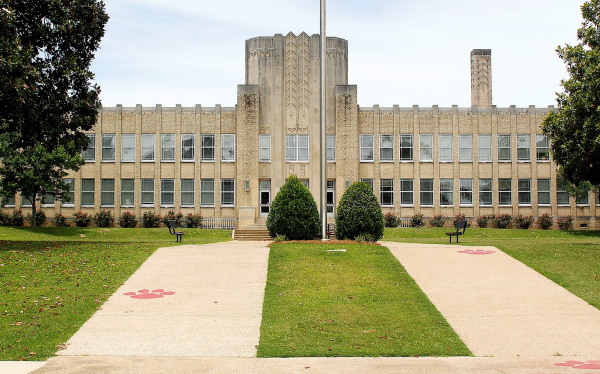School board bond proposal: money matters explained

Many of the capital projects in the Lincoln Parish School Board's $17.5 million bond proposal this spring are improvements for Ruston High School.
The Lincoln Parish School Board’s $17.5 million bond proposal, now slated for a public vote on April 27, centers on a list of capital improvement projects the board wants to perform in the Ruston district, from athletics facility upgrades to new school security measures and parking expansions.
But along with the projects themselves come matters of taxes, budgets and funding sources.
As voters in the Ruston zone of the Lincoln Parish School District begin to consider the project plan the school board unanimously approved Tuesday before it comes to an election this spring, this is the Ruston Daily Leader’s primer on a few questions residents may have on these money matters.
What's happening with the taxes?
The April 27 proposition does not include a new tax, nor is it a vote to simply renew an existing tax that would otherwise expire if the election fails.
The short version: A “yes” vote would allow a preexisting property tax to continue being levied with “no estimated increase” to the current rate of 16.75 mills for an additional five years. A “no” vote would mean that same tax would become smaller this year, smaller again in 2026, and finally roll off the books after 2036.
Usually when local governments enact property taxes and voters approve them, they’re set to run for a specific time, such as 10 years, and then require voter approval to renew, or else they come off the books.
Bond propositions are different.
Any time a school board wants to fund capital projects by issuing bonds, state law requires them to pay off those bonds by levying only a single tax in each taxing district, no matter how many different outstanding bond issues there are.
That’s what the 16.75-mill property tax in the Ruston district is. It has no set expiration date — it’s levied for as long as it takes to pay off the district’s outstanding bonds, at whatever millage rate is needed to pay them off.
This year’s proposal aside, the Ruston school district has passed three bond proposals in the past that are still outstanding.
The oldest is a $33 million package from 2004, then $3.4 million in 2011, and finally $21 million in 2013.
These packages included multiple individual issuances of bonds. The oldest of those will mature in March — meaning when property taxes are levied in late 2024, the Ruston district’s bond tax would be smaller than the current 16.75 mills.
That’ll happen again in 2026, and then in 2036 the final bond will mature, leaving nothing left to pay off, and the tax would roll off the books, according to the school board’s finance staff.
The new proposal is a five-year bond. To pay it off, the tax would remain at 16.75 mills for the next five years, rather than being reduced as it otherwise would.
One more wrinkle — the exact millage rate is all dependent on property values, and 2024 is a reassessment year in Lincoln Parish. Depending on whether property values go up or down across the Ruston district, the millage rate may fluctuate to bring in the same dollar amount as before.
Does the board need a bond issue to fund these projects?
Some have asked whether the school board could pay for some or all of these proposed projects out of its existing reserves, rather than issuing more bonds.
According to the board’s latest financial report, as of the end of December the school district had a combined balance of about $48.2 million across all funds.
But the majority of these funds come from sources that are dedicated to a specific purpose — whether by state or federal law, or because they’re taxes that the public passed to be spent in certain ways, such as teacher salaries.
Only about $19.47 million is in what the district calls its “undesignated fund balance” — money that isn’t restricted to a specific use.
For practical purposes, when it comes to what the board could spend how it wants, that’s the number that truly counts as “reserves,” Chief Financial Officer Juanita Duke said after Tuesday’s school board meeting.
But Duke said these funds have already been budgeted for operating expenses for the rest of the fiscal year, so while the board could legally use them for new projects, that would leave the day-to-day budget in the lurch.
Duke said auditing best practices recommend local agencies like school boards keep three months’ worth of operating expenses in their undesignated reserves, more or less as an emergency fund.
That would be about $15.35 million of the $19.47 million pot.
Even so, some school board members believe there may have been better ways to pay for some of the projects in the current proposal.
Vice President Danielle Williams cited the ongoing lobby expansion and other renovations of the Ruston High School gymnasium, which was financed by federal COVID- 19 relief money.
She said that money could have been spent on repairing the school’s roof, a project that now makes up $1 million of the $17.5 million bond proposal.
“There was some COVID money that was spent on projects that was not disclosed to board members,” Williams said. “I’m concerned about our priority in renovating the gym and not replacing the roof.”
She said due to time constraints in getting an election set up, she voted in favor of sending the proposal to the ballot, despite some misgivings, but she vowed increased transparency would follow.
“Moving forward, there will be checks and balances regarding finances, and I assure the public there will be accountability regarding finances,” Williams said.

